In the recent case of McMillin Management Services v. Financial Pacific Ins. Co. (2017 WL 5377823, November 14, 2017), the Fourth District Court of Appeals held that an insurer had a duty to defend a general contractor under an “ongoing operations” additional insured endorsement for damages occurring after the named insured subcontractor completed its work. The Court of Appeal determined the endorsement did not limit coverage solely to liability during the subcontractors’ ongoing operations, but rather, broadly provided coverage for liability “arising out of” such operations.
Background:
McMillin was the general contractor and developer of a residential development in Brawley, California. In that capacity, McMillin was named as additional insured (“AI”) under policies issued to concrete and stucco subcontractors by Lexington Insurance Company (“Lexington”). McMillin was also an AI on a Financial Pacific Insurance Company (“Financial Pacific”) policy issued to a drywall subcontractor. The project was completed in 2005. Both Lexington and Financial Pacific’s policy periods continued beyond the completion.
In 2010, the plaintiff homeowners sued McMillin alleging defective construction. McMillin tendered its defense to the defect litigation to Lexington and Financial Pacific under the respective AIs. Both Lexington and Financial Pacific refused to defend McMillin in the underlying litigation.
In October 2012, McMillin filed an action against Lexington and Financial Pacific for declaratory relief, breach of contract, and breach of the implied covenant of good faith and fair dealing. With respect to each claim, McMillin contended that Lexington and Financial Pacific had breached their respective contractual obligations to defend McMillin in the underlying action.
Lexington and Financial Pacific each filed a Motion for Summary Judgment, which contended that they did not owe McMillin a duty to defend the underlying action and that McMillin would therefore be unable to establish any of its claims as a matter of law.
The trial court granted both motions. The court subsequently entered a summary judgment in favor of Lexington and a separate summary judgment in favor of Financial Pacific. The trial court reasoned further that “[t]here is a distinction between ongoing operations and completed operations coverage.” (Citing, Pardee Const. Co. v. Insurance Co. of the West (2000) 77 Cal.App.4th 1340, 1340–1345 (Pardee).) the trial court further stated:
“Moreover, McMillin itself has acknowledged that [additional insured endorsement] coverage for ongoing operations ends when the subcontractor’s work is completed. [Citation.] [McMillin’s] interpretation would also run afoul of the rule that insurance contracts must be construed to avoid rendering terms surplusage. [Citation.] McMillin contend[s] the endorsement provides coverage as long as liability arose out of the subcontractors’ work. [McMillin] fail[s] to give any meaning to the phrase ‘ongoing operations.’ “
McMillin timely filed respective notices of appeal from the summary judgments in favor of Lexington and Financial Pacific.
Rationale:
1. Lexington:
In its Motion for Summary Judgment, Lexington indicated it denied coverage on the ground that its AI endorsements provided coverage to McMillin “but only with respect to liability arising out of [the named insureds’] ongoing operations.” Further, the endorsements had exclusions for “‘bodily injury’ or ‘property damage’ occurring after: (1) All work … on the project (other than service, maintenance or repairs) … has been completed; or (2) That portion of ‘your work’ out of which the injury or damage arises has been put to its intended use….”
Lexington had argued that there was no possible coverage under the endorsements because there were no homeowners who could have brought construction defect claims against McMillin during the time that the subcontractors’ operations were ongoing. Specifically, Lexington argued that because a construction defect cause of action does not accrue until discovery of a defect, and there were no homeowners who could have asserted such claims during the time of operations, McMillin could not have any liability to the plaintiffs for property damage that took place while the subcontractors were working on the project. Lexington further argued generally that the plaintiffs were making “completed operations” claims, while the endorsements only provided “ongoing operations” coverage.
McMillin had countered that the AI endorsements provided coverage “with respect to liability arising out of … ongoing operations” and argued that this language does not incorporate any limitation on when the liability must arise, but Instead, “it told McMillin at the time operations were ongoing, that any liability ‘arising out of’ those operations would be insured.”
The Court of Appeals agreed and overturned the trial court as to Lexington, noting, “even assuming that Lexington is correct that McMillin did not face any liability to homeowners during [the subcontractors’] ongoing operations, the endorsements do not state that Lexington would provide coverage solely for liability occurring during [their] ongoing operations performed for McMillin. Rather, the endorsements state that Lexington would provide coverage to McMillin for liability ‘arising out of’ such ongoing operations. The term ‘arising out of’ is, of course, not synonymous with ‘during.’”
The Court of Appeals also rejected an argument that ongoing operations AI coverage and completed operations coverage are mutually exclusive, saying that “the lack of homeowners does not establish that any property damage caused by the named insured subcontractors’ work occurred after the completion of their work. Thus, even assuming that Lexington is correct that an ‘ongoing operations’ additional insured endorsement does not provide… the same coverage afforded under a named insured’s ‘products-completed’ coverage, a homeowner’s construction defect claim is not, as Lexington suggests … necessarily one that is brought to recover under the ‘products-completed’ coverage…. On the contrary, if property damage occurs before the named insured finishes work at the jobsite … an additional insured may be entitled to coverage pursuant to an ‘ongoing operations’ endorsement.”
The Court of Appeals also found no inconsistency with its earlier decision in Pardee Const. Co. v. Insurance Co. of the West (2000) 77 Cal.App.4th 1340, because the McMillin policies were in force during construction, but “Pardee supports the proposition that an ongoing operations endorsement may be used by an insurer to make clear that there is no coverage for damages arising out of work completed prior to the inception of the policy.”
The Court of Appeals concluded with a caution that its ruling was limited to holding that the nonexistence of any homeowners when the subcontractors completed work was inconclusive on the duty to defend: “[T]he fact that there were no homeowners in the Project at the time [the subcontractors] ceased ongoing operations does not logically establish that the complaint in the underlying action did not subject McMillin to potential ‘liability arising out of[the subcontractors’] ongoing operations performed for [McMillin].’”
The Court of Appeals also noted the question whether an additional insured general contractor is covered only for damage suffered while the subcontractor is performing work was for another day: “[W]e need not decide this issue in this appeal, because Lexington has not established as a matter of law that all of the damages in the underlying action occurred after the completion of [the subcontractors’] ongoing operations…. As explained above, we do not decide whether an ongoing operations endorsement such as that used in this case provides coverage to the additional insured only for damages that occur prior to the completion of the named insured’s subcontractors’ ongoing operations…. Accordingly, we conclude that the trial court erred in granting Lexington’s motion for summary judgment.”
2. Financial Pacific
The Court of Appeals affirmed summary judgment for Financial Pacific, noting there was no allegation or evidence that the drywall subcontractor had caused damage to other property or work: “[T]he complaints … did not mention drywall or any problems caused by the installation of the drywall. The only damages the homeowners attributed to subcontractors’ work was ‘drywall and corner bead cracks and separation’ and ‘drywall nail pops.’ The Court of Appeals found no reference to any damages the installation caused to other property although McMillin cited the homeowners’ defect list submitted as part of the SB 800 claim.
McMillin cited portions of the defect list referring to water intrusion in connection with windows, patio and deck doors, and improper installation of moisture barriers at windows and doors. McMillin also cited drywall separation, window weeps clogged with stucco, drywall nail pops, and stains from water intrusion listed in the revised SB 800 claims. However, the named insured subcontractor was hired to install drywall. The Court of Appeals found no evidence that the subcontractor was responsible for installing windows and patio doors.
The Court of Appeals pointed out that in discovery McMillin was asked to identify consequential damage from the drywall, but had only repeated the items on the SB 800 defect list. “As the trial court properly concluded in citing these responses, ‘[t]here is no reference to any damage the installation caused to other property.’” “Accordingly, we conclude that the trial court properly granted Financial Pacific’s motion for summary judgment on the ground that the undisputed evidence established that Financial Pacific did not owe McMillin a duty to defend.”
Practice Point:
If you are going to issue an additional endorsement to the developer, make sure the subject endorsement is limited in its scope as to “ongoing” and “completed” operations. Otherwise, it may be subject to the court’s review and analysis.


 Privacy vs. Relevance: How Deep Can Discovery Go in Colorado Lien Cases?
Privacy vs. Relevance: How Deep Can Discovery Go in Colorado Lien Cases?
 Stale Bread: Workers Accuse Panera of Wage Theft
Stale Bread: Workers Accuse Panera of Wage Theft
 Civil Procedure Updates to Know in New York for 2025
Civil Procedure Updates to Know in New York for 2025
 Collaboration Is Key to Preparation in the Weeks Before Trial
Collaboration Is Key to Preparation in the Weeks Before Trial
 But I Didn’t Mean to Do It …
But I Didn’t Mean to Do It …
 Be Bold, Be Bright, But Be Brief…
Be Bold, Be Bright, But Be Brief…
 Taming the Wolf: Florida’s Fifth DCA Holds the Line on Tort Reform
Taming the Wolf: Florida’s Fifth DCA Holds the Line on Tort Reform
 Power of Persuasion
Power of Persuasion
 Ask Atty: William Johnson
Ask Atty: William Johnson
 Builder Must Respond To Notice Of Claim Within Statutory Time Frame As Required In California’s Civil Code
Builder Must Respond To Notice Of Claim Within Statutory Time Frame As Required In California’s Civil Code
 Damage to an Underground Storage Tank is Not a Covered Risk
Damage to an Underground Storage Tank is Not a Covered Risk
 Product Defects and The Risk-Benefit Test
Product Defects and The Risk-Benefit Test
 Courts will Allow Clarification of an Ambiguous CCP 998 Offer to Compromise in Consideration of the Offer’s Validity
Courts will Allow Clarification of an Ambiguous CCP 998 Offer to Compromise in Consideration of the Offer’s Validity
 No Coverage Where Negligence is Inseparable with Professional Service
No Coverage Where Negligence is Inseparable with Professional Service
 Court of Appeal Addresses Statutes of Limitations for Latent Construction Defects and Damage to Real Property
Court of Appeal Addresses Statutes of Limitations for Latent Construction Defects and Damage to Real Property